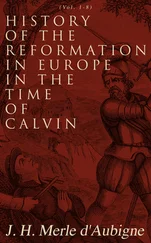The tribes, delivered from the bonds of slavery, and from the terrors of long oppression, could peaceably now pursue their way. They had yet many days' journey to Sinai, the temporary goal of their wanderings. Although the country through which they travelled was a sandy desert, it was not wanting in water, and in pasture land for the shepherds. This territory was not unknown to Moses, their leader, who had formerly pastured the flocks of his father-in-law here. In the high mountains of Sinai and its spurs, the water in the spring-time gushes forth copiously from the rocks, forms into rills, and rushes down the slopes towards the Red Sea. Nor did the Israelites suffer through want of bread, for in its stead they partook of manna. Finding this substance in large quantities, and living on it during a long time, they came to consider its presence as a miracle. It is only on this peninsula that drops sweet as honey exude from the high tamarisk trees, which abound in that region. These drops issue in the early morning, and take the globular size of peas or of coriander seeds; but in the heat of the sun they melt away. Elated by their wonderful experiences, the tribes now seemed prepared to receive their holiest treasure, for the sake of which they had made the long circuitous journey through the desert of Sinai. From Rephidim, which lies on a considerable altitude, they were led upwards to the highest range of the mountain, the summit of which appears to touch the clouds. 5To this spot Moses led the Israelites in the third month after the exodus from Egypt, and appointed their camping ground. He then prepared them for an astounding phenomenon, which appealed both to the eye and the ear. By prayer and abstinence they were bidden to render themselves fit for lofty impressions, and worthy of their exalted mission. With eager expectation and anxious hearts they awaited the third day. A wall round the nearest mountain summit prevented the people from approaching too close. On the morning of the third day a heavy cloud covered the mountain top; lightning flashed, and enveloped the mountain in a blaze of fire. Peals of thunder shook the surrounding mountains, and awakened the echoes. All nature was in uproar, and the world's end seemed to be at hand. With trembling and shaking, the old and the young beheld this terrifying spectacle. But its terror did not surpass the awfulness of the words heard by the affrighted people. The clouds of smoke, the lightning, the flames and the peals of thunder had only served as a prelude to these portentous words.
Mightily impressed by the sight of the flaming mountain, the people clearly heard the commandments which, simple in their import, and intelligible to every human being, form the elements of all culture. Ten words rang forth from the mountain top. The people became firmly convinced that the words were revealed by God. Theft and bearing false witness were stigmatised as crimes. The voice of Sinai condemned evil thoughts no less than evil acts; hence the prohibition, "Thou shalt not covet thy neighbour's wife ... nor any possession of thy neighbour." The Indians, the Egyptians, and other nations famous for their colossal structures, had, during more than two thousand years, gone through many historical experiences, which shrink into utter insignificance, when compared with this one momentous event.
The work accomplished at Sinai by an instantaneous act remained applicable to all times by asserting the supremacy of ethical life and the dignity of man. This promulgation of the Law marked the natal hour of the "distinct people," like unto which none had ever existed. The sublime and eternal laws of Sinai—coming from a Deity whom the senses cannot perceive, from a Redeemer who releases the enthralled and the oppressed—were revealed truths treating of filial duty, of spotless chastity, of the inviolable safety of human life and property, of social integrity, and of the purity of sentiment.
The Israelites had been led to Mount Sinai as trembling bondmen; now they came back to their tents as God's people of priests, as a righteous nation ( Jeshurun ). By practically showing that the Ten Commandments are applicable to all the concerns of life, the Israelites were constituted the teachers of the human race, and through them all the families of the earth were to be blessed. None of the others could then have surmised that even for its own well-being an isolated and insignificantly small nation had been charged with the arduous task of the preceptive office.
The Sinaitic teachings were not of an ephemeral nature, even in regard to their form. Being engraven on tables of stone, they could be easily remembered by successive generations. During a long period these inscribed slabs remained in the custody of the Israelites, and were called "the Tables of the Testimony," or "the Tables of the Law." Being placed in an ark, which became a rallying centre, round which Moses used to assemble the elders of the families, these tables served as a sign of the Sinaitic Covenant. They formed a link between God and the people who had formerly been trodden under foot, and who were now bidden to own no other Lord save the One from whom the Law had gone forth. It was for this reason that the ark, as the repository of the tables, was designated "the Ark of the Covenant." The ethical truths of Sinai became henceforth the basis for a new system of morality, and for the national constitution of the Israelites. These truths were further developed in special laws which had a practical bearing upon the public and private affairs of the people. Slave-holders and slaves were no longer to be found amongst the Israelites. The selling of Israelites as slaves, and perpetual servitude of an Israelite became unlawful. A man who forfeited his liberty was liable to be held in service during six years, but in the seventh year he regained his freedom. Wilful murder and disrespect to parents were punishable with death. The sanctuary could give no protection to criminals condemned to die. The murder of a non-Israelitish slave involved condign punishment. A gentile slave ill-treated by his master recovered his liberty. A man committing an offence on the virtue of a maiden was bound to make her his wife, and to pay a fine to the father of the injured woman. Equitable and humane treatment of the widow and the orphan was enforced; a similar provision was ordained for the benefit of strangers who had joined one of the tribes. The Israelites, in fact, were bidden remember their former sojourn in a foreign land, and to refrain from inflicting upon strangers the inhuman treatment which they themselves had formerly endured.
This spirit of equity and brotherly love, pervading the ancient code of laws, could not at once change the habits of the people. The duties involved in these laws were too spiritual and too elevated to have such an effect. Moses having temporarily absented himself to make preparations for the reception of the Sinaitic law, the dull-witted portion of the people imagined that their God was abandoning them in the desert, and they clamoured for the rule of a visible Godhead. Aaron, who had taken the lead in the absence of Moses, timorously yielded to this impetuous demand, and countenanced the production of a golden idol. This image of Apis or Mnevis received divine homage from the senseless multitude who danced around it. Moses, on descending from Mount Sinai, ordered the Levites to put to death some thousands of the people. Nothing but the exercise of extreme rigour could have repressed this worship of idols.
With the object of protecting the people from a relapse into idolatry, and of supporting them during their state of transition from barbarism, they were allowed to form a conception of the Deity—though not by means of an image—through some material aid which would appeal to the senses. On Sinai they had beheld flashes of lightning with flames of fire, and from the midst of a burning cloud they had heard the Ten Commandments. An emblem of this phenomenon was now introduced to remind the people of the presence of the Deity as revealed at Sinai. It was ordained that a perpetual fire should be kept alight on a portable altar, and be carried before the tribes during their migrations. Not the Deity Himself, but the revelation of the Deity at Sinai, should thereby be made perceptible to the sense of vision. The performance of sacrificial rites was a further concession to the crude perceptions of the people.
Читать дальше












